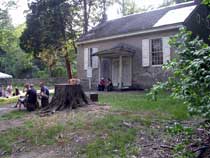 While I was out at Abington Art Center, I picked up the challenge to find the “Lost Meeting,” which has ruffled art lovers and Quakers alike on Artblog (see posts here , here, here, here, here and here. It’s one of those shows that left everyone feeling lost, one way or another. Little did the artists involved–J. Morgan Puett and spurse–realize how appropriate their title was.
While I was out at Abington Art Center, I picked up the challenge to find the “Lost Meeting,” which has ruffled art lovers and Quakers alike on Artblog (see posts here , here, here, here, here and here. It’s one of those shows that left everyone feeling lost, one way or another. Little did the artists involved–J. Morgan Puett and spurse–realize how appropriate their title was.
A good sign or two
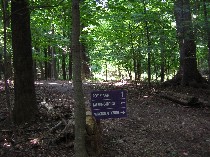 My first piece of good news is that unlike those who went before me I had no trouble finding the old Orthodox Quaker meetinghouse, following the path and multiple little signs from the Abington Art Center sculptures to the meetinghouse. Here’s a picture of a directional sign.
My first piece of good news is that unlike those who went before me I had no trouble finding the old Orthodox Quaker meetinghouse, following the path and multiple little signs from the Abington Art Center sculptures to the meetinghouse. Here’s a picture of a directional sign.
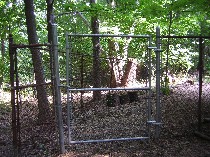 I didn’t realize the place was gated (standard hurricane fence), and was nearly deterred by the shut gate. Another sign here would have been helpful. But I screwed up my courage, opened the hasp and invaded, so no problemo.
I didn’t realize the place was gated (standard hurricane fence), and was nearly deterred by the shut gate. Another sign here would have been helpful. But I screwed up my courage, opened the hasp and invaded, so no problemo.
The building is just a sweet little thing in the midst of lawn. Whoops. The sign said it wouldn’t open until 4 p.m. But I gave the door a push and nearly scared the pants off Parker Wood, one of the spurse members who participated in the project. He was in there working on the computers.
Lost in a very small space
First I wandered around a little, which is a surprise given how small the space is. But spurse and Puett, following a bunch of computer-generated vectors, put odd stuff in odd places in the room. The result is barricades and interruptions to flow, making a tiny space exploration-worthy. To put this another way, the items in the room appear to have been placed chaotically, in order to interfere with normal flow and logical use.
The spursians would no doubt object to my use of the word chaotic, since the whole project is about patterns, and the vectors follow some computer pattern.
Wood told me that young children respond to it in a way that the adults don’t. I can see why. It’s Peewee’s Playhouse, designed according to some different drummer in a hairshirt (oy, spurse would hate the real Peewee’s Playhouse–so camp and comfortable and decorated), with dark corners, cramped spaces and multiple levels.
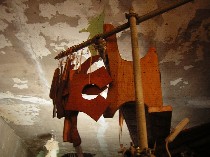
My favorite part of the installation was the old wooden clothes-making patterns. Here’s a picture of some of them. They seemed so utilitarian–and easy to make sense of. I also liked the old pattern weights with their real-world heft and giant Monopoly game-pieces look.
In contrast, the patterns being generated by the computer are for the most part strange and uninteresting all at once. The patterns are based on images of period clothing that get chewed up in algorithms and spit out as nothing like what they started as.
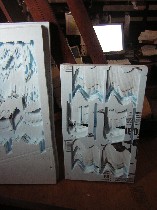
A couple of pieces they made based on the computer-generated patterns did catch my eye. Shaped by a router out of foam insulation from a CAD version of a pattern, I liked looking at them, although I found the source pattern quite puzzling (Wood was kind enough to show it to me and twirl it around in cyberspace).
Typing monkeys
But all in all, I would have to say that this project gives the tool (i.e. the computer) more power than it deserves. The result is prolific production of meaningless patterns. Wood said they would end up with a minimum of 219 paper patterns when they were done, maybe 300.
I wondered why so many and to what purpose. Wood assured me that some would be selected for use in further projects.
In other words, what’s happening here is that the creative process, which isn’t creative at all in the traditional sense, is ceded over to the computer which indiscriminately creates. Then the artist/designers take on the role of editors, weeding out what is useless and selecting what they might (or might not) be able to use.
This is a lot like email. It has given us more messages but they are of inferior quality. (All this reminds me of the proverbial monkeys who by chance might produce Shakespeare.)
I said to Wood that the thing about art is it requires human intelligence and choices. I appreciate the effort to shake things up, get at something new by taking a different tack. But ultimately, The Lost Meeting is all about creating lots of new stuff without a clear goal in the hopes that it takes them down some swell, surprising byway. I for one vote for a non-proliferation treaty. As it is, we’re drowning in aimless proliferation as a society.
As for why this belongs in the Hicksite meetinghouse, I’d have to say any connection is so tenuous as to be irrelevant.









